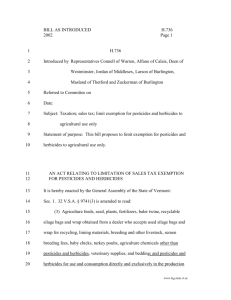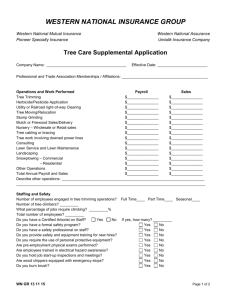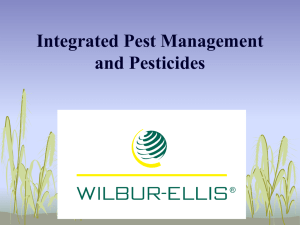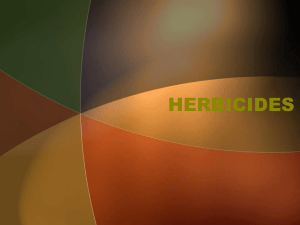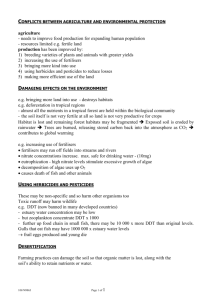Chapter 4. Characteristics of Herbicides Used for Rights-of-Way Vegetation Management Table of Contents
advertisement
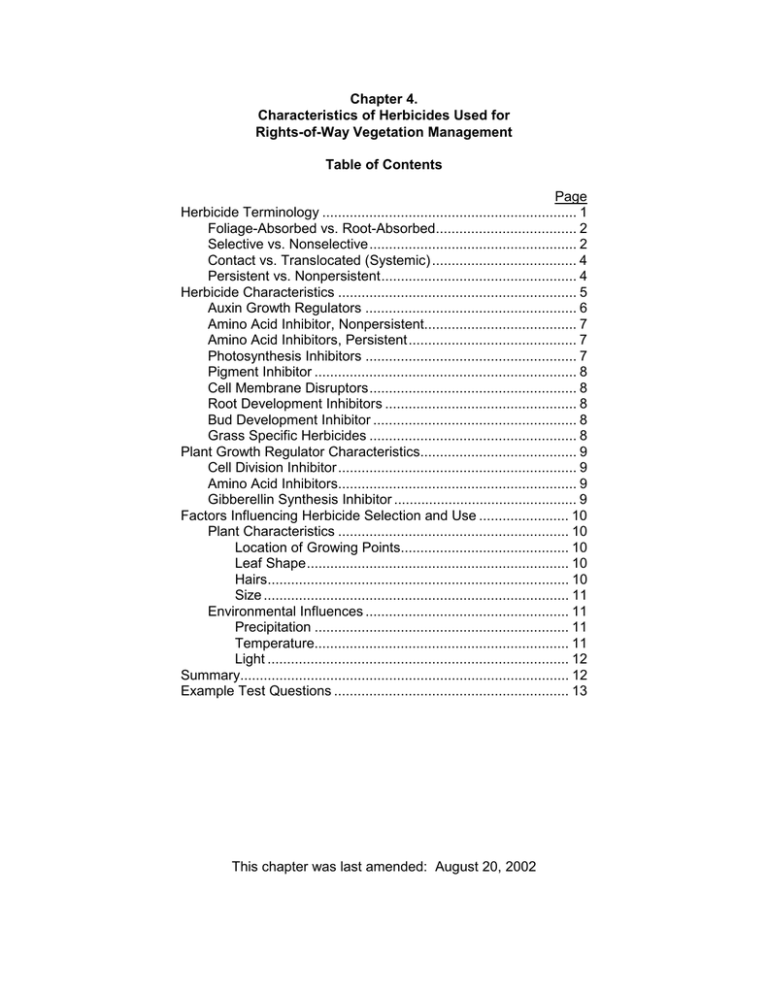
Chapter 4. Characteristics of Herbicides Used for Rights-of-Way Vegetation Management Table of Contents Page Herbicide Terminology ................................................................. 1 Foliage-Absorbed vs. Root-Absorbed.................................... 2 Selective vs. Nonselective..................................................... 2 Contact vs. Translocated (Systemic) ..................................... 4 Persistent vs. Nonpersistent.................................................. 4 Herbicide Characteristics ............................................................. 5 Auxin Growth Regulators ...................................................... 6 Amino Acid Inhibitor, Nonpersistent....................................... 7 Amino Acid Inhibitors, Persistent........................................... 7 Photosynthesis Inhibitors ...................................................... 7 Pigment Inhibitor ................................................................... 8 Cell Membrane Disruptors..................................................... 8 Root Development Inhibitors ................................................. 8 Bud Development Inhibitor .................................................... 8 Grass Specific Herbicides ..................................................... 8 Plant Growth Regulator Characteristics........................................ 9 Cell Division Inhibitor ............................................................. 9 Amino Acid Inhibitors............................................................. 9 Gibberellin Synthesis Inhibitor ............................................... 9 Factors Influencing Herbicide Selection and Use ....................... 10 Plant Characteristics ........................................................... 10 Location of Growing Points........................................... 10 Leaf Shape................................................................... 10 Hairs............................................................................. 10 Size .............................................................................. 11 Environmental Influences .................................................... 11 Precipitation ................................................................. 11 Temperature................................................................. 11 Light ............................................................................. 12 Summary.................................................................................... 12 Example Test Questions ............................................................ 13 This chapter was last amended: August 20, 2002 Herbicides Chapter 4. Characteristics of Herbicides Used for Rights-of-Way Vegetation Management _________________________________________ Important Terms amino acid synthesis inhibitors auxin growth regulators bud development inhibitor cell membrane disruptors chlorosis contact epinasty foliage-absorbed grass inhibitors leaching nonpersistent nonselective persistent photodegradation photosynthesis photosynthesis inhibitors plant growth regulators postemergent phloem preemergent restricted use pesticide root-absorbed root inhibitors selective systemic translocated xylem Herbicides are pesticides used to control unwanted vegetation (weeds). Weeds along rights-ofway include those that are a safety hazard, a nuisance, or are unsightly to the traveling public. Right-of-way weeds also include those plants that impede the use and maintenance of rights-ofway, cause injury to workers, interrupt flow of electricity or communications, are declared a noxious weed under state laws, crowd out desired native plants, damage structures and ballast, or reduce crop yield or injure livestock. Control methods applied to rights-of-way must be part of a sound weed management program that is sensitive to the environment. Herbicide application is one of the methods available to rights-of-way managers. This chapter discusses herbicides in general use for rights-of-way vegetation control. It is not expected to be all-inclusive. HERBICIDE TERMINOLOGY The effective use of a herbicide in weed management depends on knowledge of the characteristics of its active ingredient. We can classify herbicides by: 1) foliage-absorbed (postemergent) vs. root-absorbed (preemergent), 2) contact vs. translocated (systemic), 3) selective vs. nonselective, 4) persistent vs. nonpersistent, and 5) by its mode of action. Effective weed control can be accomplished by combining the characteristics of individual herbicides (assuming no incompatibility or label restrictions exist) when integrated with weed biology information. 1 Herbicides Foliage-Absorbed vs. Root-Absorbed Foliage-absorbed herbicides primarily enter the plant through the leaves which means the weeds have already emerged above the soil when spraying occurs; thus the term postemergent. Root-absorbed herbicides enter the plant through the roots. They are generally most effective when applied before the weeds emerge from the soil; thus the term preemergent. Both foliage and roots absorb some herbicides (Table 1). Herbicide formulation, method of application, and adjuvants can influence which part of the plant absorbs the herbicide. Examples of foliage-absorbed herbicides include 2,4-D, diquat, fosamine (Krenite), glyphosate, and triclopyr (Garlon). Root-absorbed herbicides include bromacil (Hyvar), diuron, oryzalin (Surflan), and tebuthiuron (Spike). Herbicides that can be absorbed by either the leaves or roots include clopyralid (Transline), hexazinone (Velpar), imazapyr (Arsenal), picloram (Tordon), and sulfometuron (Oust). Selective vs. Nonselective Selective herbicides control only certain types of plants. When applied to mixed vegetation some plant types or species will not be affected or will show minimal signs of injury. Nonselective herbicides generally control most plants and are used where complete control is desired. Selectivity may occur because of true physiological selectivity. For example, grasses are naturally tolerant to the herbicide 2,4-D whereas dandelions and ragweeds are susceptible. However, rate, timing, method of application, and plant characteristics also can determine selectivity (Table 2). Nonselective herbicides include bromacil (Hyvar), glyphosate, sulfosate (Touchdown) and tebuthiuron (Spike). Some herbicides such as diuron, hexazinone (Velpar), Table 2. Selectivity of herbicides commonly used on rights-of-way. Herbicide Plants Not Controlled 2,4-D chlorsulfuron (Telar) clopyralid (Transline) dicamba fosamine (Krenite) metsulfuron (Escort) oryzalin (Surflan) pendimethalin (Pendulum) picloram (Tordon) prodiamine (Endurance) sulfosulfuron (Outrider) triclopyr (Garlon) grasses perennial and many annual grasses grasses, many broadleaves grasses non-woody plants grasses most broadleaves many broadleaves grasses most broadleaves bermudagrass and bahiagrass grasses Table 1. Characteristics of herbicides used for rights-of-way vegetation control. 2 Herbicides Active Ingredient Trade Name Preemerge nt Postemerg ent X Selec tive X Nons elective Limited mobility Xylem Translocated Phloem Translocated X Persis -tent NonPersistent X 2,4-D several bromacil Hyvar X chlorsulfuron Telar X X X X X clopyralid Transline X X X X X dicamba several X X X diquat Reward X X diuron several fenoxaprop Horizon X X X X fluazifop Fusilade X X X X fluroxypyr Vista X X X X fosamine Krenite X X glufosinate Finale X X glyphosate several X X hexazinone Velpar X X X Imazapic Plateau X X imazapyr Arsenal X X metsulfuron Escort X X MSMA several norflurazon Predict X oryzalin Surflan X X X X pendimethalin X X X X prodiamine Pendulum Tordon, Pathway Endurance X prometon Pramitol X sethoxydim Poast sulfometuron Oust sulfosulfuron tebuthiuron picloram triclopyr X X X X X X X X X X X X X X X X X X X X X X X X X X X Outrider X X X Spike Garlon, Pathfinder X X X X X X X X X X X X X X X X X X X X X X X X X X X X X X X X X X X X X X X X X X X X X imazapyr (Arsenal), and sulfometuron (Oust) have selective uses in other situations such as crop production and forestry, but are considered to be nonselective herbicides as they are used for rights-of-way vegetation management (Table 1). 3 X Herbicides Contact vs. Translocated (Systemic) We generally think of a contact herbicide as one that kills only the green portion of the plant that it touches. The activity of these compounds is so rapid that the herbicide moves (translocates) very little in the plant. Consequently, good coverage is necessary. A contact herbicide is usually nonselective on annual species since they do not resprout. However, contact herbicides cause only temporary suppression of perennial weeds because they will resprout from the underground root system. Translocated (systemic) herbicides move throughout the plant, whether they are taken in by the foliage and translocate downward to the roots or enter the roots and translocate upward to the leaves (Table 1). Foliage applied herbicides that translocate are useful for controlling perennial weeds because the herbicide will move to and destroy the growing points in the roots, leaves, and shoots. Nearly all herbicides used for rights-of-way vegetation control translocate within the plants, including 2,4-D, bromacil (Hyvar), dicamba, diuron, glyphosate, imazapyr (Arsenal), picloram (Tordon), sulfometuron (Oust), and triclopyr (Garlon). The few contact herbicides used on rights-of-way include diquat (Reward), glufosinate (Finale), and MSMA. Persistent vs. Nonpersistent Persistent herbicides remain active in the environment for an extended time period (Table 1). The ability of the herbicide molecule to persist depends on its ability to resist microbial and chemical degradation in the soil. Herbicides vary greatly in their resistance to breakdown. Nonpersistent herbicides are short-lived in the environment. Soil microorganisms easily break them down, or they become tightly bound to soil particles and are not available to plants. Persistence is an important characteristic when long-term (residual) weed control is desired for total vegetation control around a guide rail, median barrier, substation, or rail yard. Persistence allows the control of shallow-rooted annual weeds among deep-rooted established perennial plantings. Persistence is undesirable when it hinders or delays desirable plant growth as in reseeding or plant release programs. Usually persistence increases with cold temperatures, dry, compacted or clay-textured soils, and high use rates. Conversely, warm temperatures, frequent rainfall, low use rates, sandy soils, and high organic soils reduce persistence. Herbicides generally considered to be persistent include bromacil (Hyvar), diuron, imazapyr (Arsenal), picloram (Tordon), sulfometuron (Oust), and tebuthiuron (Spike). Some nonpersistent herbicides include 2,4-D, fosamine (Krenite), glufosinate (Finale), glyphosate, and triclopyr (Garlon). 4 Herbicides Herbicide Characteristics Herbicides can be placed into broad groups by chemical family, plant response to the herbicide, and type, or mode, of action of active ingredient (Table 3). Table 3. Rights-of-way herbicides listed by general characteristics. _________________________________________________________________________________________________________________________ tebuthiuron (Spike) I. Herbicides causing injury to new growth and usually moving from leaves to roots Auxin Growth Regulators Phenoxy acid 2,4-D Benzoic acid dicamba Pyridine acid clopyralid (Transline) fluroxypyr (Vista) picloram (Tordon, Pathway) triclopyr (Garlon, Pathfinder) Amino Acid Inhibitor, Nonpersistent glyphosate Amino Acid Inhibitors, Persistent Sulfonylurea chlorsulfuron (Telar) metsulfuron (Escort) sulfometuron (Oust) sulfosulfuron (Outrider) Imidazolinone imazapyr (Arsenal) II. Herbicides causing injury to established growth and usually moving from the roots to the growing points (leaves) Photosynthesis inhibitors Triazine hexazinone (Velpar) prometon (Pramitol) Substituted urea diuron Uracil bromacil (Hyvar) Pigment Inhibitor Pyridazinone norflurazon (Predict) III. Herbicides causing localized injury with little or no movement within the plant Cell membrane disruptors Bipyridiliums diquat (Reward) Other glufosinate (Finale) IV. Herbicides applied to the soil to inhibit root development of emerging seedlings Dinitroanaline prodiamine (Endurance) oryzalin (Surflan) pendimethalin (Pendulum) V. Inhibit bud development fosamine (Krenite) VI. Grass specific herbicides Lipid biosynthesis inhibitors fenoxaprop + fluazifop (Fusion) fluazifop (Fusilade) sethoxydim (Poast) VII. Mode of action not clear Organic arsenical MSMA _________________________________________________________________________________________________________________________ 5 Herbicides Auxin Growth Regulators Auxin growth regulator herbicides [2,4-D, dicamba, clopyralid (Transline), fluroxypyr (Vista), picloram (Tordon, Pathway), and triclopyr (Garlon, Pathfinder)] act like natural plant-growth regulators. However, they are more active than natural growth regulators because they are applied at much higher rates. The plant dies, in part, because growth stops and mature tissues undergo cell division that chokes the vascular tissues. One of the common symptoms of these herbicides is distorted growth, including twisting and curling (epinasty). These herbicides: • translocate throughout the plant and are usually applied to the foliage. Because they translocate, it is not necessary to treat every part of the plant. Low-volume sprays can also provide effective control of many species. • can cause distorted plant growth at low rates. Drift to susceptible crops, such as cotton, grapes, soybeans, sugar beets, tobacco, and tomatoes, is a concern. • can move downward in the soil. Since picloram is persistent in the soil it is sometimes used for residual weed control. Some products containing picloram are classified as Restricted Use Pesticides. • are available in liquid forms as water-soluble salts (amine and mineral salts) and ester forms, emulsifiable concentrates (EC). The water-soluble formulations are usually applied to leaves and fresh cut stumps, or can be injected into woody stems. The EC formulations are best used to control woody plants, and they can be applied to young green stems or leaves of trees. • are effective for controlling many broadleaf weeds and trees. Grasses are usually not controlled (tolerant) at labeled rates. 6 Herbicides Amino Acid Inhibitor, Nonpersistent The amino acid inhibiting, nonpersistent herbicide is glyphosate. This herbicide prevents the plant from making important amino acids. It is a generally nonselective compound that must be absorbed by the leaves. However, it can be used selectively in some situations when applied at low rates, with directed methods, and/or when desired plant species are not actively growing. Glyphosate translocates throughout the plant. Symptoms in the plant occur slowly, and may take a week or more to appear. Rapid foliage discoloration (brown out) does not occur, even from concentrated sprays. There is essentially no soil activity at normal use rates because of soil adsorption. Amino Acid Inhibitors, Persistent Chlorsulfuron (Telar), metsulfuron (Escort), sulfometuron (Oust), sulfosulfuron (Outrider) and imazapyr (Arsenal, Stalker) prevent plants from making important branched-chain amino acids. Unlike glyphosate and sulfosate, all these herbicides have residual soil activity. They are taken in through the leaves and roots and translocated throughout the plant. Imazapyr and sulfometuron control many grasses and herbaceous weeds. Chlorsulfuron and metsulfuron are less effective on grasses. Although symptoms may take weeks to appear, plant growth stops soon after application. These herbicides are used at low rates (ounces or pints per acre). Photosynthesis Inhibitors These herbicides [hexazinone (Velpar), diuron, prometon (Pramitol), tebuthiuron (Spike), bromacil (Hyvar)] block photosynthesis (combining water and carbon dioxide to produce oxygen and sugar in the presence of sunlight) in susceptible plants. They have no direct effect on root growth although root uptake is the primary route for these herbicides to enter the plant. Leaves can take up these herbicides under some conditions, and with the use of certain adjuvants. All photosynthetic inhibitors persist in the soil and provide residual weed control. The length of persistence varies with each herbicide, and depends on the amount applied, soil type, and climate. 7 Herbicides Pigment Inhibitor The herbicide norflurazon (Predict) causes the new foliage to turn white because it inhibits the production of carotenoids, which leads to the destruction of the green chlorophyll in plants. Plants die because there is no production of plant food in the leaves. Norflurazon is applied preemergent and has limited soil mobility. It is considered a nonselective herbicide but does not leach deep enough in the soil to damage deeper-rooted established plants. Cell Membrane Disruptors The herbicides diquat (Reward) and glufosinate (Finale) disrupt cell membranes. They are nonselective, contact herbicides. Diquat injury may be visible a few hours after application. Chlorosis (yellowing resulting from the loss of green pigment) occurs within 2-5 days for glufosinate. Good coverage is required. Plants can recover from incomplete spray coverage. Root Development Inhibitors Herbicides that prevent seedling root development [oryzalin (Surflan), pendimethalin (Pendulum), prodiamine (Endurance)] stop the growth of roots and shoots of germinating seeds or small seedlings by disrupting cell division. Because they translocate to only a limited degree in plants, they seldom control established weeds. They are highly selective for grass control and usually do not leach in soils. Effective control depends on sufficient rainfall soon after application or soil incorporation. Bud Development Inhibitor Fosamine (Krenite) inhibits bud development when applied to woody plants late in the growing season, but before leaves start changing colors. Except for pines, there is little or no visible effect (brownout) until the following spring, when susceptible woody plants do not resume growth. Since fosamine moves only from the leaves to the buds, uniform coverage of the plant is necessary. Fosamine has no soil activity and does not injure grasses at normal use rates. Grass Specific Herbicides A common characteristic of grass specific herbicides [fenoxaprop-ethyl (Horizon), fluazifop-pbutyl (Fusilade), sethoxydim (Poast)] is that their activity is limited almost entirely to postemergent control of annual and perennial grasses. Nearly all non-grass species are resistant. These herbicides are absorbed by the leaves and have little soil activity. They are most effective when applied to unstressed, rapidly growing grasses. Death of susceptible 8 Herbicides species takes a week or more. Crop oil concentrates, nonionic surfactants, and nitrogen solutions increase their effectiveness. Antagonism has been observed when these products are tank mixed with auxin/growth regulator herbicides, such as 2,4-D. Many grass weed species have been reported to develop resistance to this group of herbicides. PLANT GROWTH REGULATOR CHARACTERISTICS Plant growth regulators (PGR) do not cause plant death, but only a reduction in plant growth. The two most common uses are for seedhead suppression of roadside grasses to reduce mowing and to reduce sprout growth after line clearance trimming on electric rights-of-way. Cell Division Inhibitor The plant growth regulator mefluidide (Embark) inhibits cell division. It reduces growth and suppresses seedhead formation of various turf grass species. It does not readily translocate out of the applied leaf. Mefluidide does not persist in the soil, but it has been shown to injure some desirable plant species. Amino Acid Inhibitors Characteristics of the herbicides glyphosate, imazapyr (Arsenal), chlorsulfuron (Telar), metsulfuron (Escort), and sulfometuron (Oust) have been previously discussed. Their use as plant growth regulators emphasizes the importance of application rate. At very low rates, some of these herbicides can be used to either suppress seedhead production of certain grasses or release desirable grasses not injured by low rates. Gibberellin Synthesis Inhibitor Paclobutrazol (Profile) is a tree growth regulator that inhibits the biosynthesis of gibberellins, plant growth substances that stimulate cell division and cell elongation. Inhibition of cell division and elongation limits tree growth, especially resprouting stimulated by pruning. Growth inhibition can usually last for several (2-4) years. Stem cambial growth of some tree species is also inhibited by paclobutrazol. It is injected into the soil or applied as a drench around the base of the tree. 9 Herbicides FACTORS INFLUENCING HERBICIDE SELECTION AND USE The previous section discussed many aspects of the chemical nature of herbicides. However, there are plant characteristics and environmental conditions that can influence the effect a herbicide has on a plant. Plant Characteristics Location of Growing Points Seedling grasses have their growing point at or below the soil surface. Postemergent control is difficult when growing points are protected in this manner and the herbicide does not move in the phloem. If a herbicide does not reach the growing point, the plant will continue to grow. Creeping perennial grasses have protected buds below the soil surface. Many seedling broadleaf weeds have exposed growing points at the top of the young plant and in the leaf axils. Many perennial broadleaf plants are difficult to control because of the protected buds on the creeping roots and stems. Translocated herbicides are necessary to reach these protected growing points. Leaf Shape The shape of the leaf can reduce or improve the effectiveness of a herbicide. Spray solution tends to bounce or run off when applied to a plant with narrow vertical leaves. In contrast, a vertical leaf can also direct the chemical downward into the growing point. A broadleaf plant with horizontal, flat, wide leaves can more easily retain the spray solution. Retention of spray solution is critical to the effectiveness of contact herbicides, which must be absorbed through the foliage. Hairs Some weeds lack hairs on their leaves and stems; others have many and varied hairs. A dense layer of leaf hairs can hold the herbicide droplets away from the leaf surface, reducing chemical absorption into the plant. However, a thin layer of leaf hairs causes the chemical to stay on the leaf surface longer than normal, allowing more chemical to be absorbed into the plant. Surfactants will facilitate greater spreading and penetration of the herbicide solution through a dense layer of hairs. Generally, there are fewer and shorter hairs on seedling weeds compared with the older growth stages. For this and other reasons, seedlings are easier to control than mature plants. 10 Herbicides Size Seedling and small weeds are easier to control than larger established weeds. Smaller plants, regardless of their stage of growth, are usually easier to control than larger plants. Lower rates can be used on seedling weeds, but more chemical is needed as the plants become larger. Contact herbicides can be effective on seedling weeds before perennial root systems become established. Environmental Influences Precipitation Soil moisture and rainfall affect herbicide efficacy. They also influence how long herbicides stay on soil and plant surfaces. Herbicides work best with moderate soil moisture. Excessive soil moisture may keep the herbicide in solution and increase leaching through the soil. Some rain is beneficial after application of root-absorbed herbicides because it moves the herbicide into the soil and in the root zone. Rain during or soon after foliar applications may wash herbicides off the leaves and reduce uptake and effectiveness. During drought periods plants are stressed and growth is slowed. This causes most translocated herbicides to perform poorly. Even contact herbicides do not perform well under drought conditions as plants produce heavy wax or corky layers of tissue on leaves or stems that protects against excessive transpiration losses. During dry periods herbicides remain on the soil surface until moisture is received to carry them to the root zone. Effectiveness may be reduced if herbicides remain on the soil surface for a long period of time (several days) before rainfall. Temperature Temperature generally does not affect final weed control. It may, however, affect the amount of time required for the herbicide to kill the weed. As temperature increases, the herbicide effects occur more quickly. In cold weather, the action of herbicides may be slowed. High temperatures can enhance herbicide volatility (change from a liquid to a gas or vapor). Warm temperatures increase soil temperature, which increases microbial activity. This can reduce the persistence, hence effectiveness, of residual, soil-active herbicides. 11 Herbicides Light Sunlight is essential for photosynthesis and growth. Light may break down some herbicides if they remain on the soil or plant surface for a long time. This process is called photodegradation. Soil incorporation is an effective way of eliminating photodegradation. Since soil incorporation is not possible for rights-of-way, herbicides used on rights-of-way are not light sensitive. SUMMARY Herbicides registered for use on rights-of-way may be used to control almost all plant species or to selectively manage for broad groups of plants. Most vegetation management programs will use only a small number of the products available. Other products are available that are mixtures of the active ingredients of herbicides discussed above. Premixed and tank mixed combinations offer convenience and utilize the desired characteristics of each component. Each product has its unique advantages that enable it to occupy a market niche, but some products may not be suited for a particular weed control operation. Before using any herbicide, read the label for the best source of information. 12 Herbicides Chapter 4 Example Test Questions 1. Herbicide selectivity can be influenced by: A. Time of application B. Rate of application C. Method of application D. All of the above 2. Herbicides that move in a plant are termed: A. Selective B. Contact C. Translocated (systemic) D. Persistent 3. Herbicides that injure some plants and not others are termed: A. Contact B. Selective C. Volatile D. Nonpersistent 4. Herbicides that remain active in the soil for a large part of the growing season are termed: A. Translocated B. Nonselective C. Persistent D. Selective 5. Herbicides that kill or injure a broad spectrum of plants are termed: A. Nonselective B. Persistent C. Translocated D. Postemergent 6. A herbicide that is applied before the weeds emerge is termed: A. Selective B. Nonpersistent C. Contact D. Preemergent 7. Herbicides that kill only the green portion of the plant they land on are termed: A. Selective B. Nonpersistent C. Contact D. Postemergent 8. Herbicides that are applied after the weeds have emerged through the soil are termed: A. Selective B. Postemergent C. Contact D. Nonpersistent 13 Herbicides 9. Herbicides that do not remain active in the environment for very long are termed: A. Nonselective B. Leachable C. Preemergent D. Nonpersistent 10. The changing of the active ingredient to a gaseous form is: A. Solubility B. Volatility C. Drift D. Leaching Answers: 1. D 3. B 5. A 7. C 9. D 2. C 4. C 6. D 8. B 10. B 14
